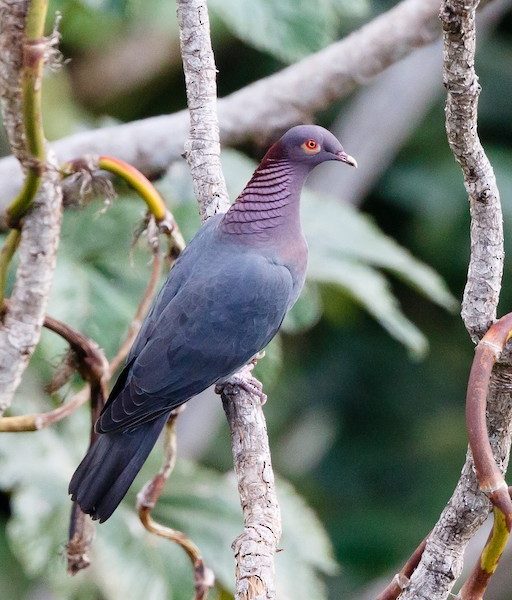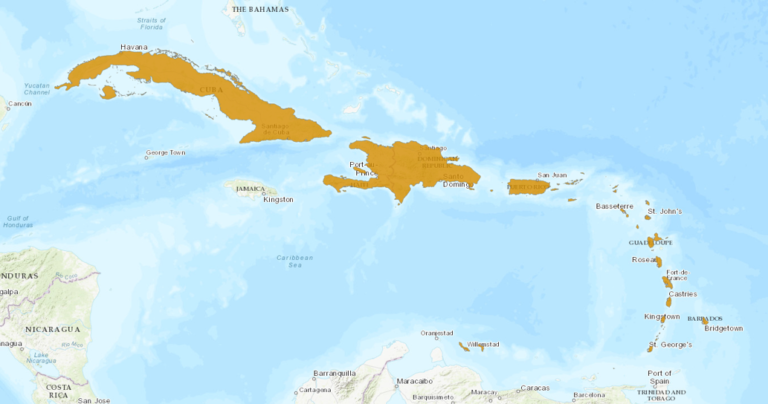Birdfinding.info ⇒ Common in forests and semiopen habitats across much of its range. Especially numerous and ubiquitous on Puerto Rico (despite extensive hunting) and the Virgin Islands. Uncommon and local on Cuba, where it is found mainly mountains and the Zapata Swamp region. Locally common in the mountains of Hispaniola; uncommon in the lowlands. In the Lesser Antilles, it is common on Saba, St. Eustatius, St. Kitts, Montserrat, Dominica, and from St. Lucia to Grenada; uncommon or localized on the other islands. In the ABC Islands, it is generally common throughout Bonaire, but less so on Curaçao, mainly at its western end in and around Christoffel National Park.
Scaly-naped Pigeon
Patagioenas squamosa
Endemic to the West Indies from Cuba to the Lesser Antilles, where it occurs in forests and open woodlands, both humid and dry. On some islands it also occurs in scrub and locally in urban areas.
Resident throughout Cuba, the Isle of Youth, Hispaniola, Puerto Rico, the Virgin Islands, the Lesser Antilles south to Barbados and Grenada, Curaçao, Bonaire, and Venezuela’s Frailes and Testigos islands. Recent records indicate that it may be colonizing Tobago, Great Inagua, and Turks & Caicos.
Extirpated from Aruba around 1930. Vagrant to Jamaica and Florida (two old records from Key West: October 24, 1896, and May 6, 1929).
Identification
Unique and distinctive: slate-gray body and wings; maroon hood with glittering “scaly” nape; bicolored bill with red base and pale tip; and bright red eyering with orange undereye-comb.

Scaly-naped Pigeon. (Cupeycillo Trail, Alejandro de Humboldt National Park, Cuba; January 27, 2016.) © Martjan Lammertink
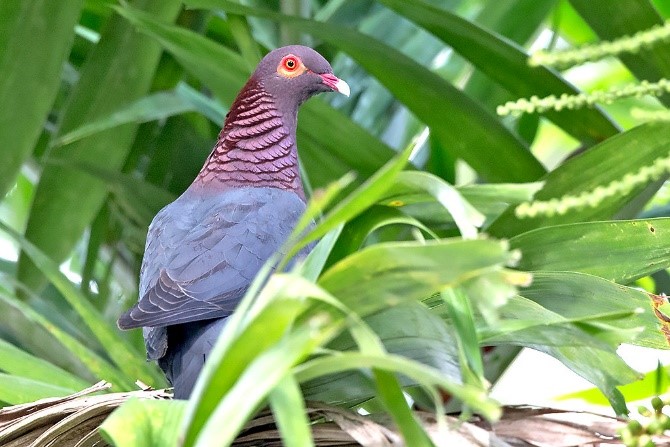
Scaly-naped Pigeon, with its scaly neck ruff raised to full advantage. (Barbados; February 24, 2017.) © George Foster
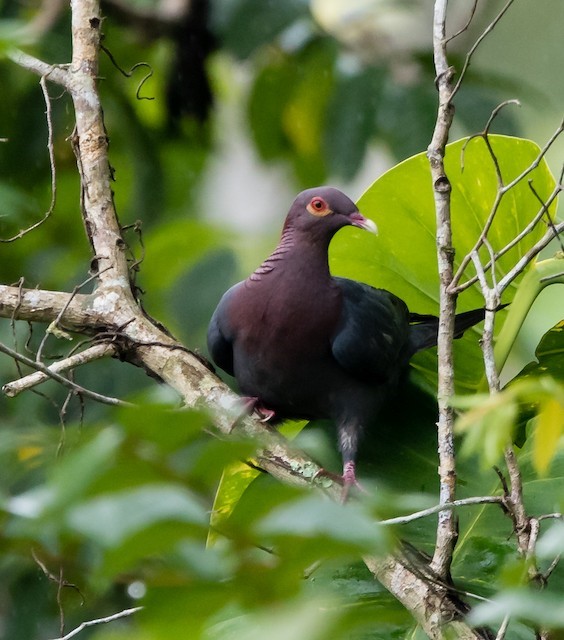
Scaly-naped Pigeon. (Lago Cidra, Puerto Rico; May 27, 2018.) © José Santiago
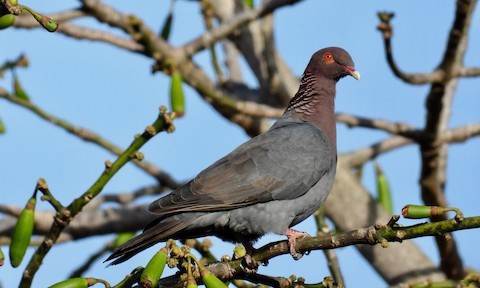
Scaly-naped Pigeon. (Sion Hill Plantation, St. James, Barbados; February 17, 2019.) © Grete Pasch
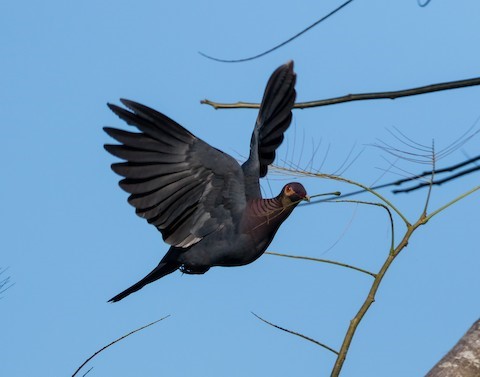
Scaly-naped Pigeon, showing dark gray underwing. (Humacao, Puerto Rico; March 29, 2018.) © José Santiago

Scaly-naped Pigeon. (Little Fountain, St. Croix, U.S. Virgin Islands; May 31, 2008.) © Charles D. Peters, M.P.R.
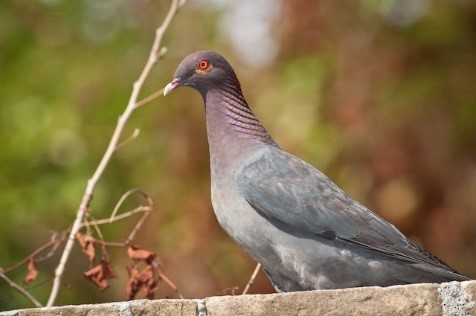
Scaly-naped Pigeon, appearing much paler than most. (Francis Bay, St. John, U.S. Virgin Islands; January 16, 2011.) © Stephen Davies
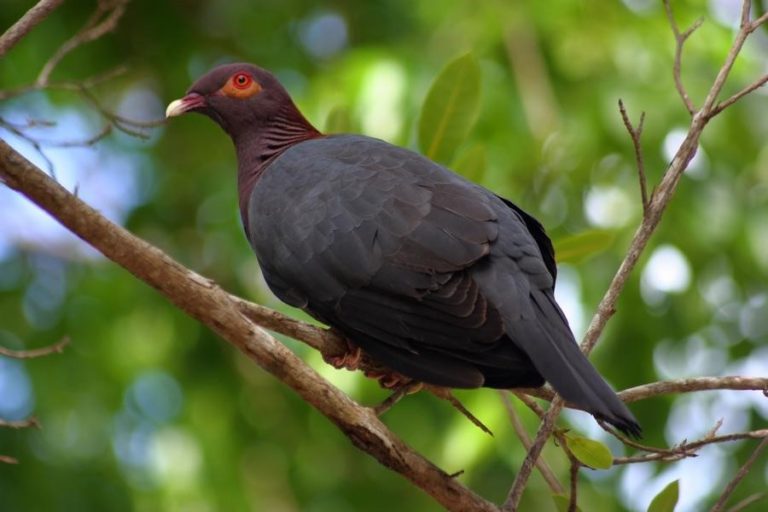
Scaly-naped Pigeon, in indirect lighting. (Culebra, Puerto Rico; April 28, 2017.) © Rémi Bigonneau
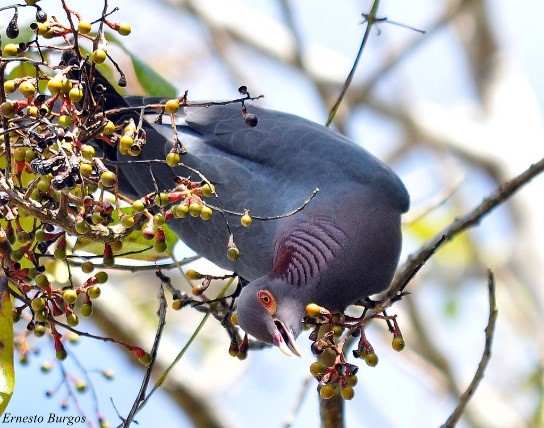
Scaly-naped Pigeon, feeding upside-down. (Barrio Naranjo, Comerío, Puerto Rico; April 25, 2009.) © Ernesto Burgos

Scaly-naped Pigeon. (Christ Church, Barbados; November 9, 2017.) © Ian Jarvie

Scaly-naped Pigeon, in flight—note prominence of pale bill tip and eye-comb. (St. George’s University, Grenada; July 27, 2013.) © Frantz Delcroix
Notes
Monotypic species.
References
Ascanio, D., G.A. Rodriguez, and R. Restall. 2017. Birds of Venezuela. Christopher Helm, London.
Baptista, L.F., P.W. Trail, H.M. Horblit, P. Boesman, and G.M. Kirwan. 2019. Scaly-naped Pigeon (Patagioenas squamosa). In Handbook of the Birds of the World Alive (J. del Hoyo, A. Elliott, J. Sargatal, D.A. Christie, and E. de Juana, eds.). Lynx Edicions, Barcelona. https://www.hbw.com/node/54127. (Accessed September 3, 2019.)
BirdLife International 2016. Patagioenas squamosa. The IUCN Red List of Threatened Species 2016: e.T22690241A93267191. http://dx.doi.org/10.2305/IUCN.UK.2016-3.RLTS.T22690241A93267191.en. (Accessed September 3, 2019.)
eBird. 2019. eBird: An online database of bird distribution and abundance. Cornell Lab of Ornithology, Ithaca, N.Y. http://www.ebird.org. (Accessed September 3, 2019.)
ffrench, R. 2012. A Guide to the Birds of Trinidad & Tobago (Third Edition). Cornell University Press, Ithaca, N.Y.
Garrido, O.H, and A. Kirkconnell. 2000. Field Guide to the Birds of Cuba. Cornell University Press, Ithaca, N.Y.
Gemmill, D. 2015. Birds of Vieques Island, Puerto Rico: Status, Abundance, and Conservation. Special issue of The Journal of Caribbean Ornithology, BirdsCaribbean, Scholarly & Specialized Publishing, Charlottesville, Virginia.
Gibbs, D., E. Barnes, and J. Cox. 2001. Pigeons and Doves: A Guide to the Pigeons and Doves of the World. Yale University Press, New Haven, Connecticut.
Latta, S., C. Rimmer, A. Keith, J. Wiley, H. Raffaele, K. McFarland, and E. Fernandez. 2006. Birds of the Dominican Republic and Haiti. Princeton University Press, Princeton, N.J.
Meyer de Schauensee, R., and W.H. Phelps, Jr. 1978. A Guide to the Birds of Venezuela. Princeton University Press, Princeton, N.J.
Raffaele, H. 1989. A Guide to the Birds of Puerto Rico and the Virgin Islands. Princeton University Press, Princeton, N.J.
Raffaele, H., J. Wiley, O. Garrido, A. Keith, and J. Raffaele. 1998. A Guide to the Birds of the West Indies. Princeton University Press, Princeton, N.J.
Wells, J.V., and A.C. Wells. 2017. Birds of Aruba, Bonaire, and Curaçao. Cornell University Press, Ithaca, N.Y.
